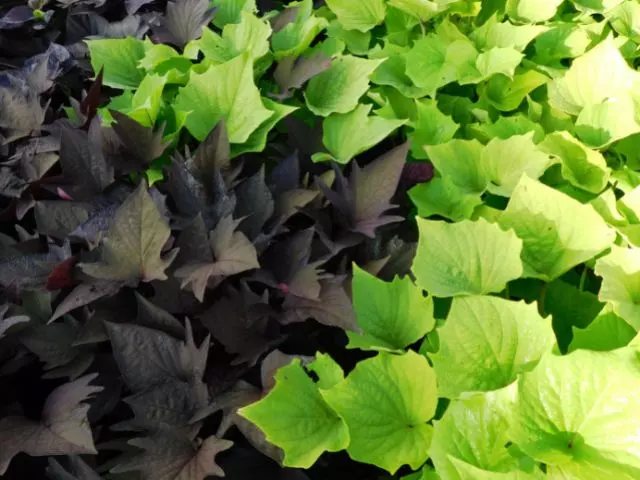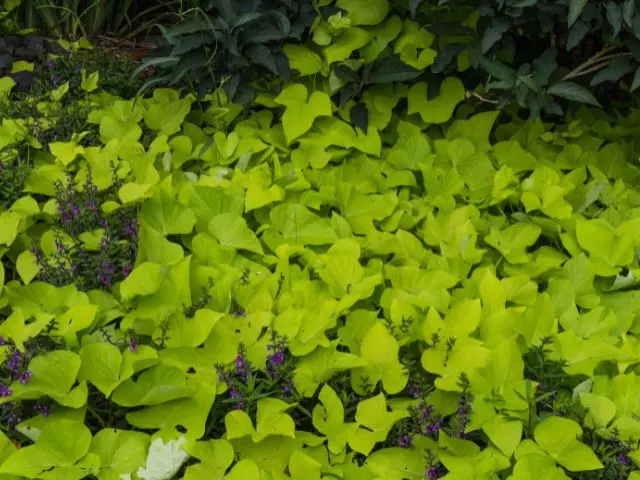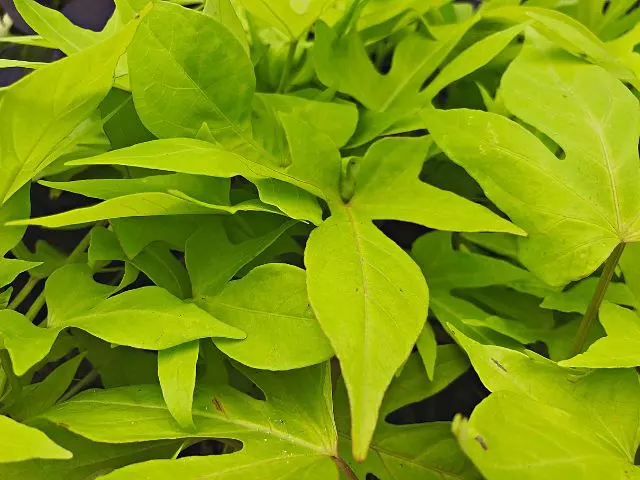Sweet potato vines are a type of flowering plant that belongs to the Ipomoea genus. They are native to tropical and subtropical regions of the Americas but have been widely cultivated and naturalized throughout the world. Continue reading to find out when to plant a sweet potato vine.
Sweet potato vines are exclusively ornamental, and their tubers are not suitable for consumption like the edible variety of sweet potatoes that are consumed regularly. Sweet potato vine is a low-maintenance plant that can adapt to various growing conditions, including high temperatures, moisture levels, and low-light conditions.
Table of Contents
When to Plant Sweet a Potato Vine
When to Plant Sweet a Potato Vine? Sweet potato vines are planted in spring when soil temperatures are above 50 °F (10 °C). It is recommended to check the frost calendar before planting the sweet potato vine because it does not tolerate frost.
In very hot regions it is best to plant the sweet potato vine in early spring so that the plant adapts and does not suffer from the extreme summer. Planting the sweet potato vine in early spring will allow the plant to settle in properly.
In cold climate regions, it is best to wait until the soil temperature is above 50 °F (10 °C) because the sweet potato vine is not a very cold-tolerant plant. In addition, you can use a mulch to protect the roots of the plant and promote moisture retention.
Sweet potato vines can be planted at any time of the year in areas with USDA hardiness zones between 8b and 11 where temperatures remain above 70 °F (21 °C) all year round. In these areas, the sweet potato vine is considered a perennial.

Where to Plant a Sweet Potato Vine
Where to Plant a Sweet Potato Vine? Sweet potato vine is a plant that grows quickly and develops very well if it is planted in a suitable place for its growth. This is a sun-loving plant and if provided with at least 6 hours of sunlight per day it will grow perfectly. Sweet potato vine also thrives in partial shade but will grow more slowly.
Soil suitable for sweet potato vine growth should be rich in organic matter and have good drainage to prevent root rot. If you plant the sweet potato vine in a pot, make sure it has drainage holes. To maintain soil moisture, you can use mulch.
In areas with very intense heat, a little afternoon shade will benefit the sweet potato vine, which prefers the sun but not the extreme heat of summer. Additionally, during the spring you can provide fertilizer to the plant to promote growth and development.
How to Plant a Sweet Potato Vine
How to Plant a Sweet Potato Vine? As mentioned above, the sweet potato vine grows and develops very easily with the right conditions of light and water. Follow these steps to plant sweet potato vines in your garden or pot:
Choose a location with lots of sun exposure or partial shade exposure. Sweet Potato Vines will not do well in shade.
Dig a hole that is twice the size of your sweet potato vine’s root ball.
Plant the vine in the hole, ensuring that the highest point of the root ball is slightly above the soil level.
Cover the roots of the plant with soil and lightly tamp them down.
Water thoroughly to ensure good soil contact with the roots of the plant.
Place a thick layer of mulch around the base of the plant to help retain moisture.
Prune your sweet potato vine to the desired shape and size, once established.
Unless you live in USDA Hardiness Zones 8b to 11 make sure the risk of frost has passed to plant sweet potato vines. On the other hand, if you are going to plant a potted sweet potato vine indoors, the planting time is not a problem.

Types of Sweet Potato Vine
Sweet potato vine is a common name for a group of plants that are all members of the Ipomoea batatas species. Some of the most popular types of sweet potato vine include:
Margarita Sweet Potato Vine (Ipomoea ‘Margarita’): This vibrant-colored trailing vine has chartreuse, lime green, and creamy yellow foliage that looks great in pots and baskets. The University of Oklahoma mentions that this variety of sweet potato vine and others are susceptible to grasshoppers and deer.
Blackie Sweet Potato Vine (Ipomoea ‘Blackie’): An ornamental type with deep purple-bronze foliage and a vining habit that’s great for adding accent and texture to landscapes.
Black Heart Sweet Potato Vine (Ipomoea ‘Black Heart’): An evergreen type with dark foliage and a bushy, upright growth habit — considered one of the best varieties for adding color to shade gardens.
Red Ipomoea Sweet Potato Vine (Ipomoea ‘Red’): This variety grows long, deep-red vines that look great when trailing down a container or wall.
Neon Sweet Potato Vine (Ipomoea ‘Neon’): A bold, bright-orange flowering species with captivating foliage that offers a unique trellising effect.
- Sweet Potato Plant Pot: Ipomoea, also known as Sweet Potato Vine, is a beautiful, tender, perennial plant that features bold-colored, five-lobed leaves. The color of the variegated foliage ranges from green to deep, dark purple, almost verging on black
- Outdoor and Indoor Plants: Sweet Potato Blackie plants bloom with stunning lavender to pale purple-colored, trumpet-shaped flowers. In the fall, the edible sweet potato tubers can be harvested. The USDA hardiness zone for outdoor planting is 9–11
- Easy Maintenance: Easy to care for, Sweet Potato Vine plants thrive in full sunlight to partial shade, with the ideal temperature ranging from 65-85° F. A heat pack is included with each plant if your region experiences cold weather
Final Conclusions
Planting sweet potato vines is not difficult at all and the best thing is that it is a fast-growing plant. Remember that the best time to plant sweet potato vines is in the spring or when soil temperatures are above 50 °F (10 °C).
I hope this article clears up all your questions about when to plant sweet potato vines. The tubers of these varieties are not edible. To consume the tubers you will have to plant sweet potatoes, I recommend you read our article about how to plant sweet potatoes.


